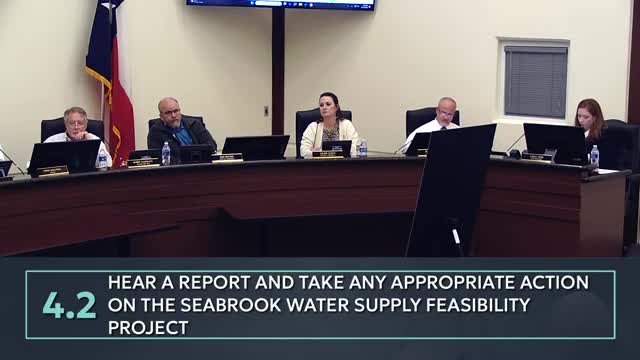Seabrook explores water supply solutions amid growth pressures
December 03, 2024 | Seabrook, Harris County, Texas
Thanks to Scribe from Workplace AI , all articles about Texas are free for you to enjoy throughout 2025!

This article was created by AI using a video recording of the meeting. It summarizes the key points discussed, but for full details and context, please refer to the video of the full meeting. Link to Full Meeting
The Southeast Water Treatment Plant, which supplies water to Seabrook through a pipeline built in the late 1980s, is nearing the end of its operational lifespan. As the city’s population continues to grow, the demand for water is projected to increase significantly, with estimates suggesting a need for up to 4.5 million gallons per day in the future. Currently, Seabrook uses between 2.5 and 3 million gallons daily during peak times.
Lackey outlined several potential sources for additional water, including partnerships with nearby municipalities such as Lake City and La Porte, as well as the Gulf Coast Water Authority. However, discussions revealed that these options may not be feasible due to existing agreements and capacity limitations. For instance, both Lake City and La Porte have already secured their future water needs and cannot provide the volume required by Seabrook.
A key development from the meeting was the city’s inclusion in ongoing discussions about expanding the Southeast Plant, which could open the door for Seabrook to become a direct partner in the future. This partnership would allow the city to secure water at a lower cost compared to current rates paid through Pasadena, which are expected to rise.
The estimated cost for constructing a new pipeline to connect Seabrook directly to the Southeast Plant is approximately $36 million for an 8-mile route, while a longer 14-mile route to the Gulf Coast Water Authority could cost around $92 million. City officials are exploring potential grant opportunities to help fund this infrastructure, which could alleviate some financial burdens.
The meeting underscored the urgency of addressing Seabrook's water supply challenges, as the city must plan for its future water needs while navigating complex partnerships and financial considerations. As the feasibility study progresses, city leaders will continue to evaluate their options and seek solutions to ensure a sustainable water supply for the community.
Converted from City of Seabrook, Texas December 3, 2024 Regular City Council Meeting meeting on December 03, 2024
Link to Full Meeting
Comments
View full meeting
This article is based on a recent meeting—watch the full video and explore the complete transcript for deeper insights into the discussion.
View full meeting
